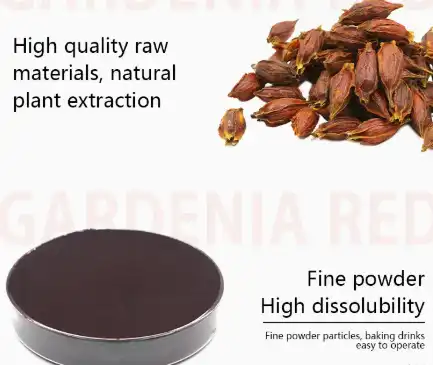Gardenia Red Powder, derived from the fruit of the Gardenia jasminoides plant, has been used for centuries in traditional Chinese medicine and as a natural colorant. In recent years, there has been growing interest in its potential as a natural dye for various applications. This blog post explores the use of Gardenia Red Powder as a natural dye, its properties, and its applications in different industries.

What are the benefits of using Gardenia Red Powder as a natural dye?
Gardenia Red Powder offers several advantages as a natural dye, making it an attractive option for those seeking eco-friendly and sustainable coloring solutions. Here are some key benefits of using Gardenia Red Powder as a natural dye:
- Environmental friendliness: As a plant-based dye, Gardenia Red Powder is biodegradable and does not contribute to environmental pollution. Unlike synthetic dyes, which often contain harmful chemicals, Gardenia Red Powder is a more sustainable choice for coloring textiles, food, and cosmetics.
- Versatility: Gardenia Red Powder can produce a range of colors from pink to red, depending on the concentration and pH level. This versatility makes it suitable for various applications, including textile dyeing, food coloring, and cosmetic pigmentation.
- Non-toxic nature: Gardenia Red Powder is generally considered safe for use in food and cosmetics. It has been used in traditional Chinese medicine for centuries, indicating its low toxicity and potential health benefits.
- Natural antioxidant properties: The main pigment in Gardenia Red Powder, crocin, is a powerful antioxidant. This property not only contributes to its coloring abilities but may also offer additional benefits in food preservation and skincare applications.
- Stability: Gardenia Red Powder exhibits good stability under various conditions, including heat and light exposure. This stability makes it a reliable choice for long-lasting color in different products.
These benefits have led to increased interest in Gardenia Red Powder as a natural dye across various industries. Its potential to replace synthetic dyes in many applications aligns with the growing consumer demand for natural and sustainable products.
How is Gardenia Red Powder extracted and processed for use as a dye?
The extraction and processing of Gardenia Red Powder involve several steps to ensure the highest quality and concentration of the pigment. Here's an overview of the process:
- Harvesting: The process begins with harvesting the fruits of the Gardenia jasminoides plant. These fruits are typically harvested when they are fully ripe, as this is when they contain the highest concentration of pigments.
- Drying: After harvesting, the fruits are carefully dried to remove moisture. This step is crucial as it helps preserve the pigments and prevents spoilage. The drying process can be done naturally in the sun or using controlled drying chambers.
- Grinding: Once dried, the fruits are ground into a fine powder. This increases the surface area of the material, making it easier to extract the pigments in the next step.
- Extraction: The powdered fruits are then subjected to an extraction process. This typically involves using a solvent, such as water or ethanol, to dissolve and extract the pigments from the plant material. The choice of solvent can affect the final color and properties of the dye.
- Filtration: After extraction, the mixture is filtered to remove any solid plant material, leaving behind a liquid containing the dissolved pigments.
- Concentration: The filtered liquid is then concentrated through evaporation or other methods to increase the pigment concentration. This step is crucial for producing a potent dye.
- Drying: The concentrated liquid is dried to form a powder. This can be done through spray drying or other drying techniques that preserve the pigments' integrity.
- Quality control: The final product undergoes various quality control tests to ensure its purity, color intensity, and stability.
The extraction and processing methods can significantly impact the quality and properties of the Gardenia Red Powder. Advanced techniques, such as supercritical fluid extraction, are being explored to improve the efficiency and quality of the extraction process. These methods aim to produce a more concentrated and stable pigment while minimizing the use of potentially harmful solvents.
It's worth noting that the specific extraction and processing methods may vary depending on the intended use of the Gardenia Red Powder. For example, the process for producing food-grade dye may differ from that used for textile dyes to ensure compliance with relevant safety regulations.
In which industries is Gardenia Red Powder commonly used as a natural dye?
Gardenia Red Powder has found applications in various industries due to its natural origin and versatile coloring properties. Here are some of the key industries where Gardenia Red Powder is commonly used as a natural dye:
1.Food and Beverage Industry: Gardenia Red Powder is widely used as a natural food coloring agent. It's particularly popular in Asian cuisines and is used to color various food products, including: Its use in the food industry is driven by the increasing consumer demand for natural ingredients and clean label products.
- Confectionery and baked goods
- Beverages and dairy products
- Sauces and condiments
- Processed meats
2. Textile Industry: Gardenia Red Powder is gaining popularity in the textile industry as a natural alternative to synthetic dyes. It's used to dye various fabrics, including: The growing interest in sustainable and eco-friendly fashion has led to increased demand for natural dyes like Gardenia Red Powder in textile production.
- Cotton
- Silk
- Wool
- Linen
3. Cosmetic Industry: The cosmetic industry has embraced Gardenia Red Powder as a natural colorant for various products, including: Its use in cosmetics aligns with the trend towards natural and organic beauty products.
- Lipsticks and lip balms
- Blushes and other makeup products
- Natural hair dyes
- Skincare products
4. Pharmaceutical Industry: While not as common, Gardenia Red Powder is sometimes used in the pharmaceutical industry for coloring pills and capsules. Its natural origin makes it an attractive option for manufacturers looking to produce more natural or herbal remedies.
5. Arts and Crafts: Artists and craftspeople often use Gardenia Red Powder as a natural pigment for:
- Painting
- Dyeing paper
- Creating natural inks
- Coloring handmade soaps and candles
The use of Gardenia Red Powder in these industries is part of a broader trend towards natural and sustainable products. As consumers become more environmentally conscious and health-aware, the demand for natural dyes like Gardenia Red Powder is expected to grow.
However, it's important to note that while Gardenia Red Powder offers many advantages as a natural dye, its use also comes with some challenges. These include:
- Consistency in color: Natural dyes can sometimes produce variations in color, which can be challenging in industries requiring strict color consistency.
- Stability: While generally stable, natural dyes may be more sensitive to environmental factors compared to some synthetic dyes.
- Cost: The production of natural dyes can be more expensive than synthetic alternatives, which can impact their widespread adoption.
- Regulatory compliance: The use of natural dyes in certain industries, particularly food and cosmetics, must comply with relevant safety regulations and standards.
Despite these challenges, ongoing research and technological advancements are helping to improve the performance and applicability of Gardenia Red Powder as a natural dye across various industries.
If you are also interested in this product and want to know more product details, or want to know about other related products, please feel free to contact lea_slsbio@163.com,WhatsApp+86 13193326505.

References
1. Wang, L., et al. (2018). "Gardenia yellow pigment extraction and its application in food." Journal of Food Science and Technology, 55(4), 1297-1306.
2. Yusuf, M., et al. (2017). "Eco-friendly dyeing of wool using aqueous extract of the roots of Indian madder (Rubia cordifolia) as natural dye." Journal of Natural Fibers, 14(1), 80-88.
3. Shahid, M., et al. (2013). "Recent advancements in natural dye applications: a review." Journal of Cleaner Production, 53, 310-331.
4. Feketea, G., & Tsabouri, S. (2017). "Common food colorants and allergic reactions in children: Myth or reality?" Food Chemistry, 230, 578-588.
5. Yusuf, M., et al. (2017). "Dyeing studies with henna and madder: A research on effect of tin (II) chloride mordant." Journal of Saudi Chemical Society, 21(6), 726-735.
6. Gürses, A., et al. (2016). "Dyes and pigments: their structure and properties." In Gürses, A., et al. (Eds.), Dyes and Pigments (pp. 13-29). Springer, Cham.

